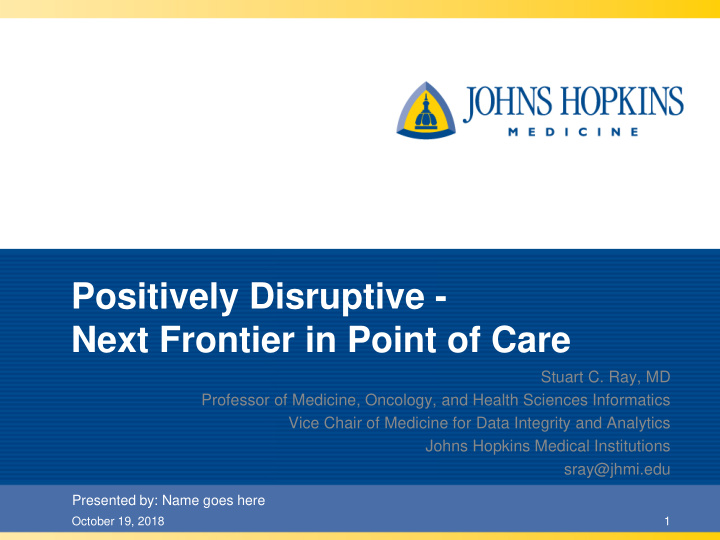



Positively Disruptive - Next Frontier in Point of Care Stuart C. Ray, MD Professor of Medicine, Oncology, and Health Sciences Informatics Vice Chair of Medicine for Data Integrity and Analytics Johns Hopkins Medical Institutions sray@jhmi.edu Presented by: Name goes here October 19, 2018 1
Disclosures • Johns Hopkins University receives research grant support from miDiagnostics, Inc., including laboratory research overseen by Dr. Ray • The terms of this arrangement are being managed by the Johns Hopkins University in accordance with its conflict of interest policies 10/19/2018 2
This speaker’s context • Internal medicine, infectious diseases physician at Johns Hopkins Hospital • Laboratory researcher dedicated to eliminating HCV • Performing sponsored research to develop technology that would enable “point of need” tests 10/19/2018 3
Disruption of healthcare diagnostics • What’s currently broken? • How can we foster positive solutions? 10/19/2018 4
We do want positive solutions
Point of Care diagnostics • Niche solutions • Diverse definitions – Disposable/embedded/wearable – Handheld – Portable – Benchtop – Transportable 10/19/2018 6
Disruptive POC testing • Turn around time less than visit length • Clinical accuracy comparable to central lab • Accessible in all patient locations • 2-way data interface with EHR 10/19/2018 7
Centralized testing is efficient for the lab doing the test • The Core lab at JHH performs about 10 million tests/year, no downtime, extensively automated • It’s often said that a CBC costs less than $1 to run, based on volume of testing and device costs • What are the costs outside of the lab? 10/19/2018 8
Cycles of Centralization & Decentralization Centralization fosters: • (+) Process consistency • (+) Enhanced reliability • (+) Cost control • (-) Process over service Larry Thaler, 2016 10/19/2018 9
Where does your blood go? • Specimen collection via venipuncture • For CBC, blood tubes are 3-5 milliliters • The blood volume inspected by the analyzer is less than 30 microliters 10/19/2018 10
Getting into patient context The clinician must re-load the patient context into her mind each time: • A patient visit occurs • A test result is reviewed • A test result is discussed Time and error accumulate with each context disruption, because each is a gap in care 10/19/2018 11
Example: Complete Blood Count (CBC) • White blood cells (WBC) – Differential (neutrophils, lymphocytes, etc) • Red blood cells (RBC) – Indices (MCV, RDW, etc) • Platelets Among the most ordered of all tests 10/19/2018 12
High-level view of WBC proportions Source: Wikipedia
Complete blood count (CBC) Unexplained bleeding (bleeding from gums) Current Future • Visit doctor’s office • Visit doctor’s office • At end of visit, check • Perform CBC at PON out and go to lab for • If normal, look for multiple tests other causes • Wait for result (hours • If abnormal (low or days) platelets, anemia, • Return to clinic or abnormal WBC), discuss (hours or days) make next decision • May require further in context iterations
Complete blood count (CBC) Unexplained bleeding (bleeding from gums) Current Future • Visit doctor’s office • Visit doctor’s office • At end of visit, check • Perform CBC at PON out and go to lab for • If normal, look for multiple tests Benefits: other causes • Wait for result (hours • Reduce cost of care (fewer tests) • If abnormal (low or days) • Reduce time to accurate diagnosis platelets, anemia, • Return to clinic or • Improve coherence of care abnormal WBC), discuss (hours or days) • Patient-centered care make next decision • May require further • Minimize context disruption in context iterations
Parallel testing • Hard to resist for clinicians – Numerous tests have the veneer of getting to the answer quickly, reducing cycles of context disruption • Antithesis of Choosing Wisely initiatives • Unnecessary tests are wasteful, directly and indirectly • Follow-up on all tests can be challenging 10/19/2018 16
Failure to follow up • Failure to follow up on test results: – can result in significant errors including delayed/missed cancer diagnosis, yet – it occurs for 7-62% of laboratory tests sent from ambulatory clinics [Callen, 2012] . • There are many potential IT/EHR tactics, including automated notifications and reminders; none solves the problem Callen JL, et al. J Gen Intern Med 2012; 27(10): 1334–1348 10/19/2018 17
Diagnostic testing is a gap in patient engagement Stephen Armstrong https://hellohealth.com/blog/the-patient-engagement-pyramid/ 10/19/2018 19
Was Moore’s Law a prophecy? • “Cramming more components into integrated circuits” (1965) Moore GE Electronics 1965 10/19/2018 20
Moore’s Law ourworldindata.org 10/19/2018 21
Moore’s Law was a self-fulfilling prophecy • Staying on the curve has depended on investments, by many players, to developing innovative processes years ahead of revenue • Anticipation enabled innovation 10/19/2018 22
Not all curves are like Moore’s https://www.genome.gov/sequencingcosts/ 10/19/2018 23
Relevant needs • Prevent iatrogenic harm • Prevent/reveal errors • Reduce time to accurate diagnosis • Reduce wasteful care • Improve coherence of care • Patient-centered care (empowerment) • Minimize context disruption for providers
How can health systems foster positive disruption? • Identify testing pathways that could be short-circuited by specific POC tests for common diagnoses/problems • Estimate total costs of current versus anticipated solution • Articulate the value of positively- disruptive technology solutions 10/19/2018 25
What does the future look like? • Rapid, accurate, inexpensive diagnostic devices in the hands of clinicians and then patients • Multi-omic integration of tests on chip • AI-assisted management of signal and noise Who will drive, and who will follow? 10/19/2018 26
Recommend
More recommend